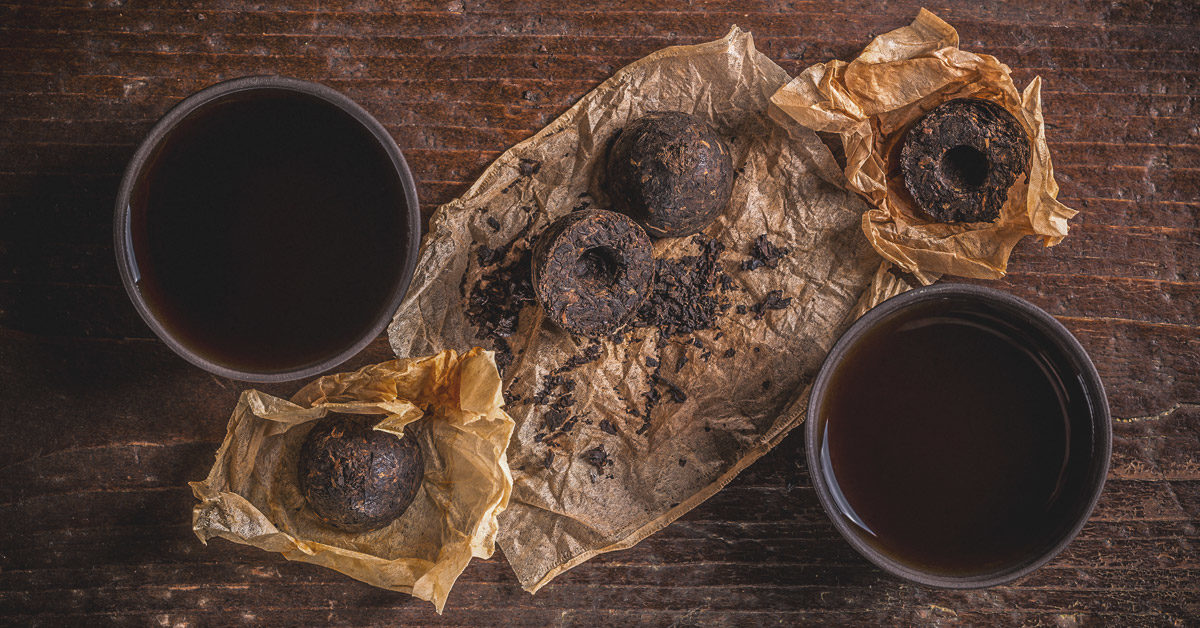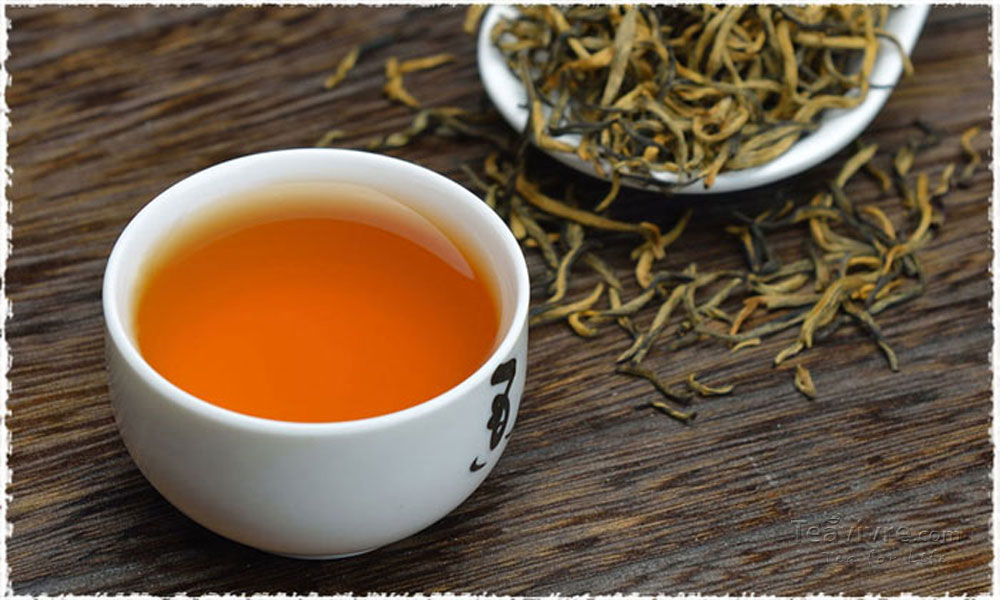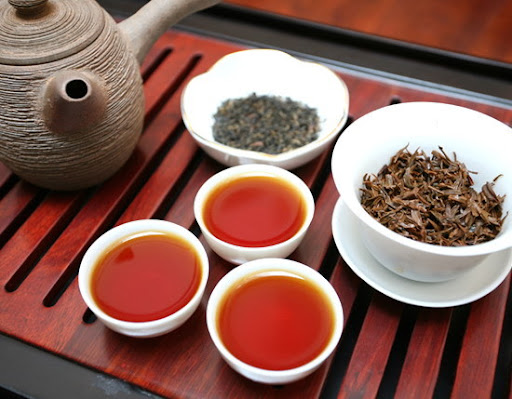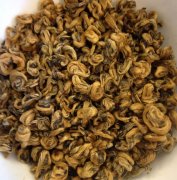The difference between Pu'er raw tea and cooked tea A detailed explanation of the brewing method for women to drink raw tea or cooked tea.
1. View shapes and colors.
The first step in choosing Pu'er tea is to look at the appearance of the tea. Appearance mainly depends on the color and texture of dry tea. The mildew spot on the tea indicates that the storage is improper and the product quality is poor. Pu'er raw tea is fresh and tender and dark green.
The color of cooked tea is darker and reddish brown than raw tea.
two。 Tea color
The color of tea soup reflects the quality of production technology, storage year and storage method of Pu'er tea. Good Pu'er tea is translucent. According to the different storage time, the colors are yellow, gold, yellow-orange and chestnut red. Raw tea is light yellow or golden yellow, more translucent. Mature tea is dark red or even reddish brown. The color is bright and clear.

3. Aroma and taste.
After long-term storage, Pu'er tea naturally has a strong aroma, the more mature, the stronger the aroma. During storage, tea can easily absorb other odors that will damage the taste of the tea. Pu'er tea should not have a musty taste. If so, it proves that the storage method is incorrect.
4. Efficacy.
As we all know, Pu'er tea has many health benefits. however, the efficacy of raw tea is very different from that of cooked tea. In the choice, you can also consider the functional requirements of each variety.
Raw tea: contains a lot of tea polyphenols, tea flavor fragrance, can be used for detoxification, bring mild calories, actually make hot conditions more comfortable, but also refreshing, making it very suitable for drinking in summer. However, it is not advisable to drink too much before going to bed because the drinks contain caffeine.
Mature tea: many studies have shown that the enzymes in mature tea have anti-arteriosclerosis, anti-inflammatory and anti-aging properties. A warm clay drink that is thought to be more suitable for cold temperatures, such as winter.
How to brew Pu'er tea?
The brewing method of Pu'er tea is different from other teas, which is related to the unique characteristics of Pu'er tea. Pu'er tea is a kind of big-leaf tea in Yunnan, which is usually compressed. The fermentation process means that with the passage of time, it will have its own characteristics. The longer the age, the stronger the aroma. The brewing method of Pu'er tea is mainly mastered from the following five aspects.
1. Brewing apparatus
Purple sand teapot (suitable for cooked Pu'er tea): because cooked Pu'er tea needs to be awakened by high temperature, the purple sand teapot has pores, good air permeability and good heat preservation. Mature Pu'er tea can well preserve its aroma and soil flavor, so it is best to choose purple sand teapot to brew.
Purple sand teapot (suitable for raw Pu'er tea): when brewing raw Pu'er tea, if the water temperature is too high, the tender tea will lose its freshness. Raw tea contains high levels of tea polyphenols and caffeine. In order to avoid adding bitterness, it should be quickly extracted and brewed to prevent excessive brewing. Purple sand teapot has high density and good thermal conductivity, so it is more suitable for producing Pu'er. As the water temperature required for brewing is naturally low, it is appropriate to use a teapot with fast heat dissipation; high density helps to maintain the aroma of tea.

Cover bowl (most commonly used): because the cover bowl does not absorb flavor, so you can taste its true taste. The color changes of Pu'er tea can be appreciated at will, so capping cups are the most commonly used brewing utensils in modern tea art, but using them requires more skill, otherwise it will become very hot.
two。 Tea weight
In the brewing method of Pu'er tea, the addition of tea is also an important factor affecting the brewing taste.
The standard ratio is 200ml: 5g, that is, you put 200ml of water and 5g of tea together, that is, the tea ratio is 1:40, which can be changed according to the degree of brewing you like.
If you drink Pu'er tea every day, it is more appropriate to put about 10 grams of tea in the 300ml pot. If you are worried about the estimated grams of tea, we suggest buying an electronic scale.
3. Water temperature
In the brewing process of Pu'er tea, water temperature is the key factor affecting the taste of Pu'er tea.
Pu'er tea uses Yunnan Daye tea as the raw material, the leaves are thick and usually compressed, so higher temperature and heat are needed to break up the leaves. The normal water temperature for cooked Pu'er tea is 99-100℃, but the requirements for water temperature of Pu'er tea in different years and different processes are slightly different.
In terms of complexity, the brewing method of Pu'er tea, especially fresh tea within 3 years, depends not only on the year, but also on the tenderness of the raw materials.
For example, Shengpu should be boiled at a water temperature of about 95 °C. After the boiled water is boiled, we can let it sit for a while, let the heat out and lower the temperature slightly. In this way, you can avoid scalding fresh leaves, which will affect the freshness of the taste.
4. Awakening tea
"Xingcha" is the process of storing tea in a more open and ventilated environment for 1-2 weeks, which awakens the first desired taste. The process is different, depending on whether it is raw or ripe.
If the raw Pu'er tea is put in an open environment, there is generally no need to wake up the tea, unless the current open environment is too humid, otherwise it may damage the tea. Usually, raw Pu'er tea that needs to be awakened is stored in purple sand cans or other semi-sealed containers to obtain suitable airflow.
[how to wake up tea]
1. Raw tea
Take the raw Pu'er tea you need to drink in the open air, for example, it will take about half a month to a month.
two。 Cooked tea
Or, pry open the ripe Pu'er tea and put it in a ventilated jar for a week before drinking.

3. Wash tea
Another process of awakening tea before making tea is called "washing tea". Put the tea in the teapot, pour it into hot water and let it soak for about 10 seconds. The aim is to increase the temperature of tea and tea-making equipment. This liquid should be thrown away.
Pu'er tea is brewed for 5-10 seconds before the first five brewing and 10-15 seconds after the sixth brewing. After the tenth brewing, the brewing time can be appropriately prolonged to maintain the taste strength of the tea. The more times you brew, the more time you need to add. The recommended brewing time depends on the strength and intensity of the tea. Some Pu'er teas take a long time to brew and take two or three trials to achieve the desired taste.
Pu'er tea is more resistant to brewing than ordinary tea, and its taste will fade after 10-20 times of brewing. After making tea, drain the tea as far as possible, and add fresh boiled water next time to avoid soaking for too long, reduce the number of tea brewing, and avoid affecting the color, aroma and taste of tea. If you want to pause, you should pour the tea dry and take the lid off.
Some misunderstandings in the making of Pu'er tea, you need to know.
1. Repeatedly boiling water.
Some people boil water in kettles and boil too much at a time. In fact, repeated boiling is harmful to water quality. The oxygen content in the water is too low to stimulate the tea. It is appropriate to use initial boiling water and second boiling water to make tea. Do not cook for a long time to avoid the impact of water quality on Pu'er tea.
two。 I forgot to heat up the teacup and teapot.
Heating cups and teapots with hot water can help remove odors and reduce the impact of the surrounding environment on tea.
3. It takes too long to wash tea.
It is designed to make the tea break down to a better taste. It should be about 10 seconds, but it depends on the quality of Pu'er, and the first brewing should be discarded every time. Brewing for too long will affect the total output of Pu'er tea, because the taste of Pu'er tea will be diluted when brewing.
Important Notice :
前街咖啡 FrontStreet Coffee has moved to new addredd:
FrontStreet Coffee Address: 315,Donghua East Road,GuangZhou
Tel:020 38364473
- Prev

Five major brewing factors of hand-brewed coffee: grindability, gouache ratio, brewing temperature of hand-brewed coffee
Why? Why? These three simple words, we may have asked ourselves hundreds of times a day (exaggeration) do not believe you listen to me to count. Why does the alarm clock ring so timely every day? Why do you have to work today? Why does a week go by so quickly? . (giggling) after a series of struggles, we almost stepped on the spot and were almost late.
- Next

Yunnan Red Golden snail belongs to what kind of tea and what grade long-term drinking Yunnan black tea
1. Generally speaking, spring tea is better than summer and autumn tea. Spring tea is strong and fat, with a hard structure, good transparency and uniform leaves. Summer rests in the rainy season. Buds and leaves grow fast and internodes grow long. Although the buds are exposed, the clarity is low, and the bottom of the leaves is slightly hard and mixed. Autumn is the dry and cold season of tea trees, the growth and metabolism of tea trees is weakened, the tea body is light and clear.
Related
- Beginners will see the "Coffee pull flower" guide!
- What is the difference between ice blog purified milk and ordinary milk coffee?
- Why is the Philippines the largest producer of crops in Liberia?
- For coffee extraction, should the fine powder be retained?
- How does extracted espresso fill pressed powder? How much strength does it take to press the powder?
- How to make jasmine cold extract coffee? Is the jasmine + latte good?
- Will this little toy really make the coffee taste better? How does Lily Drip affect coffee extraction?
- Will the action of slapping the filter cup also affect coffee extraction?
- What's the difference between powder-to-water ratio and powder-to-liquid ratio?
- What is the Ethiopian local species? What does it have to do with Heirloom native species?

